WHICH LEATHER TO CHOOSE?
The choice of leather must be made according to the creation to be made. Each animal has its particularities in terms of flexibility, thickness or surface of the skin . It is important to note that each hide is unique and that the mechanical properties of the leather are therefore not identical across the entire surface (especially for bovine leather). Leather is a durable material used in many sectors: leather goods, clothing, saddlery, gloves, shoemaking... It is an inimitable and timeless material. Discover in this guide the different tanning, leather finishes and the particularities specific to each animal.
WHERE TO BUY LEATHER?
Find the ideal leather for your next creation among our wide range of leather skins in varied colors and various finishes. Our goal is to offer quality leathers accessible to everyone.
WELCOME TO THE LEATHER PLANET
50% OF OUR LEATHER COMES FROM CLEARANCE
We find for you end-of-series leathers or old collections from major leather goods manufacturers , shoe brands or luxury brands to offer them for sale. This is why most of our leathers are offered in limited series and this is also what allows us to offer you affordable prices. Without knowing it, you give a "responsible" side to your creations by helping us to recycle this beautiful material - UPCYCLING .
50% OF OUR LEATHER IS MADE FOR YOU
In order to offer you permanent ranges and allow you to perpetuate some of your creations, we have our own ranges of leather manufactured: Satinlys, Sweet 2, Automobile... OUR LEATHER COMES MAINLY FROM EUROPEAN TANNERIES.
THE DIFFERENT TANNINGS
Tanning consists of transforming the skin into leather using tannins, substances of different natures which make it possible to go from putrescible skin to a rot-proof material: leather (source: CNC).
Leather is a durable material used in many sectors: leather goods, gloves, shoemaking, textiles, saddlery... It is an inimitable and timeless material. The term "leather" can only be used when the skin of an animal has been transformed.
|
VEGETABLE TANNING |
MINERAL TANNING (CHROMIUM) The most common method because around 85% of leathers are mineral tanned and therefore require little maintenance. Use of mineral tannins: chrome salts, iron salts... The growth of this tanning is primarily due to a demand from customers who do not accept that a leather bag is damaged due to rain. This should make it possible to avoid regular maintenance. |
 |
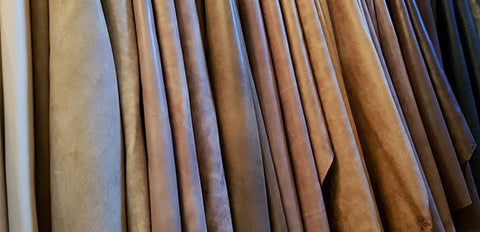 |
COMBINED TANNING
Tanning which combines 2 tanning families to obtain leather which combines the qualities of the tannins used. For example: Vegetable Chrome.
SYNTHETIC TANNING
Use of synthetically produced tannins. The composition is close to that of vegetable tannins.
TANNER OR TANNER?
The material is worked in tanning for bovine leather and in tannery for goat and sheep leather.
- The tanner works with large raw hides (calf, young cattle, cows, young calves, bulls, buffalo).
- The meat maker prepares the small, thinner skins (lamb, sheep, goat, ostrich).
The different parts of bovine leather
Discover our guide which presents the different parts of bovine leather as well as their respective qualities.
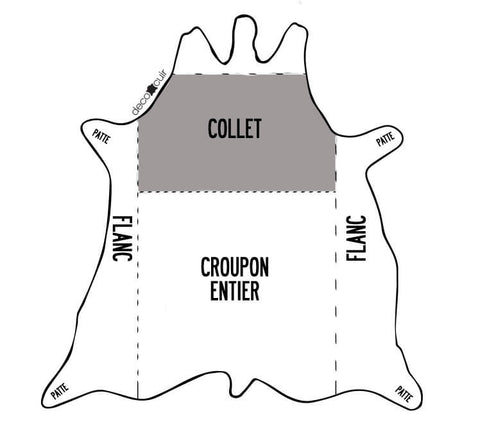
HOW DO I KNOW IF MY LEATHER HAS VEGETABLE OR MINERAL (CHROMIUM) TANNING?
We invite you to watch the video (below) from the Radermercker tannery which explains the flame technique.
This technique consists of burning a piece of your leather: if the ashes are greenish it is mineral tanning.
WHAT IS LEATHER AND HOW IS IT MADE?
Several manufacturing steps are necessary to transform a hide into leather: river work (preparation for tanning) , tanning, dyeing and grinding/finishing . To find out more about each step, we invite you to consult the complete guide from the National Leather Council.
LEARN MORE >
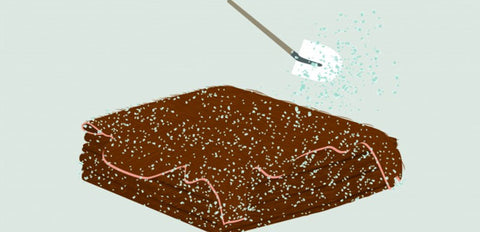 |
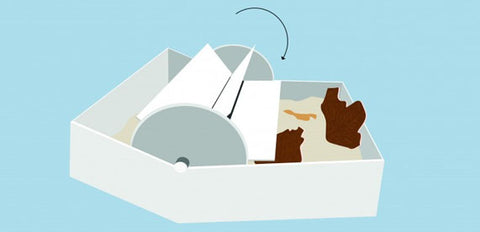 |
| ©Noémie DAVAL - National Leather Council | ©Noémie DAVAL - National Leather Council |
To find out more, we invite you to watch the video of “Les tanneurs français”.
LAYERS OF SKIN
THE MAIN LEATHER FINISHES
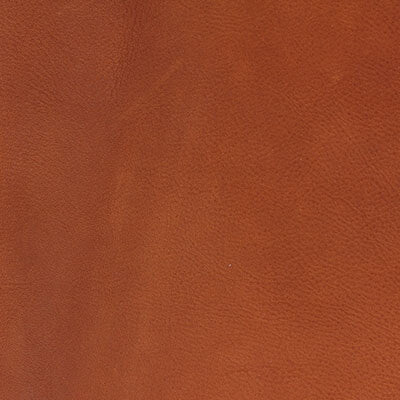 |
 |
 |
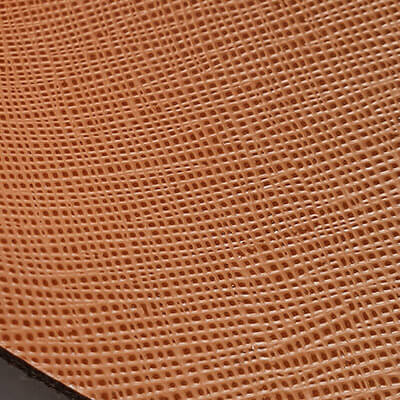 |
|
FULL GRAIN LEATHER Leather having retained its original grain (outer layer intact) . It is the “noblest” leather in the leather family. |
SPLIT LEATHER Leather from which the grain has been removed by splitting. |
VELVET CRUST Velvety-looking product obtained from a crust. |
LEATHER / COATED SPLIT Leather / Crust covered with a thick finish on the surface. The leather has been finished with polyurethane (PU). |
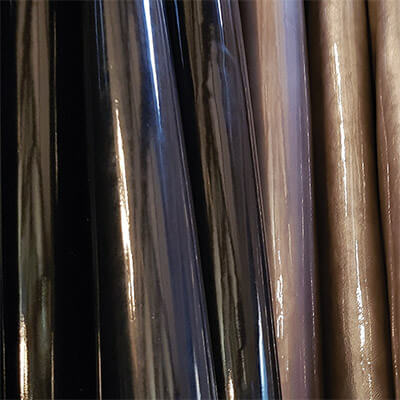 |
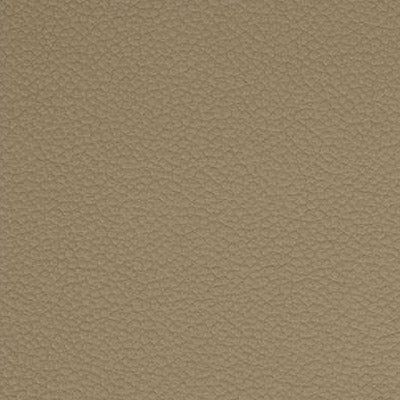 |
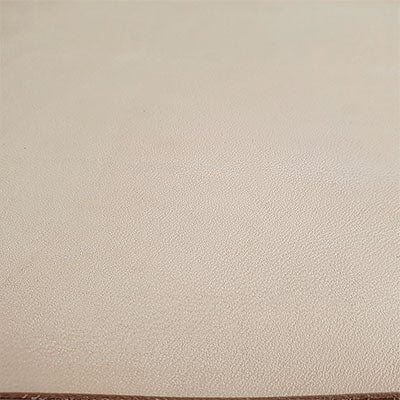 |
 |
|
PATENT LEATHER Leather coated with a layer of varnish or a film (waterproof). |
CORRECTED GRAIN LEATHER Leather whose grain has received light sanding to eliminate defects. It will receive various finishes: pigmented, grained... |
NATURAL LEATHER Leather having no surface finish. |
FANCY LEATHER Leather with an original finish: metallic, imitation crocodile, snake... |
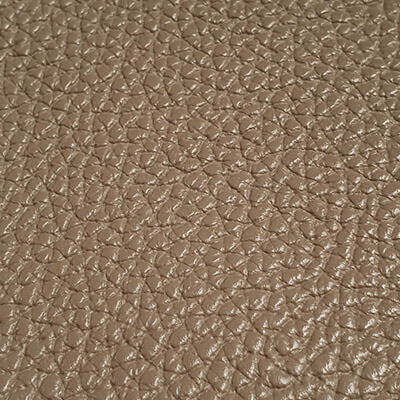 |
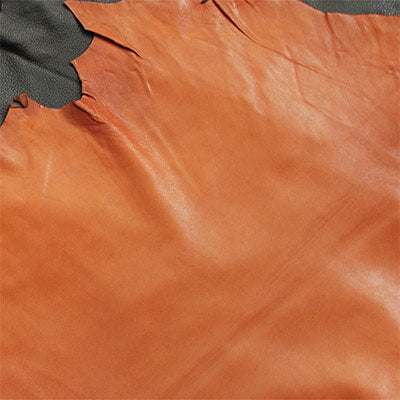 |
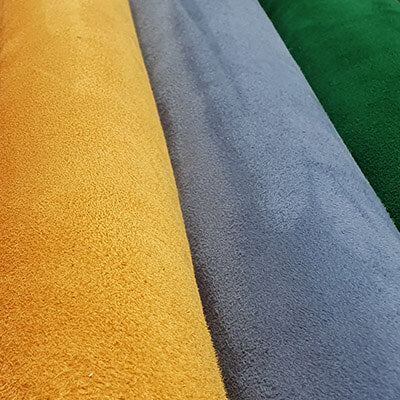 |
 |
|
GRAINED LEATHER** Leather having undergone a graining operation by a tanner (not natural). |
NAPPA LEATHER Soft, smooth, fine and resistant full-grain leather from lambskins, calfskins, etc. |
VELVET LEATHER* Velvety-looking leather obtained by sanding the flesh side (crust - opposite of nubuck). |
NUBUCK LEATHER Velvety-looking leather obtained by sanding the grain. Nubuck leather is a high-end leather: “peach skin”. |
A LITTLE VOCABULARY...
 |
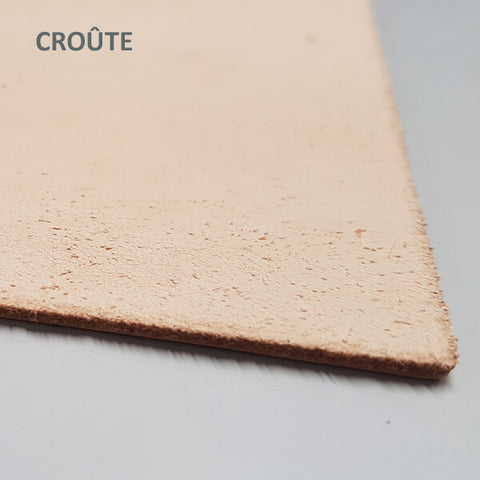 |
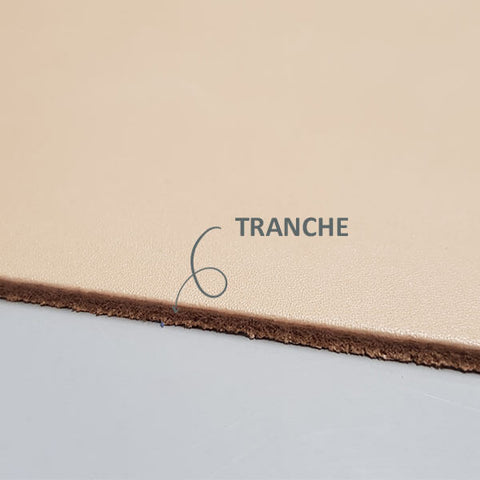 |
|
FLOWER This is the place of a leather: the side of the leather which supports the hair. It is smooth, grained, velvet... |
FLESH SIDE It's the back of the leather, it's quite fluffy. |
SLICE This is the leather side. The edges can be worked with an eraser or edge finisher. |
WHAT IS TILLED LEATHER?
Tumbled leather is leather that has gone through fullers to be softened (a kind of large washing machine that works dry and sometimes with hot air) . This operation can last several hours depending on the suppleness of the leather that you want to obtain.
*WHEN DO WE TALK ABOUT VELVET?
Unlike Nubuck, suede is sanded on the flesh side. This leather has a more fibrous structure than nubuck. It is sometimes called suede or suede*. It is generally made from skins that have a grain with defects in order to transform the reverse side of the skin into suede leather to enhance it. In this case the flower side remains as is, with its defects, because only the suede leather side must be visible in the item created. Suede leather can also be made from split leather. In this case, one side will be velvet, the other can be either raw or velvet. Generally suede leather is quite supple. This leather is often used to make linings, bellows, soft items such as purses, work shoes or gloves. This leather is more economical than full grain leathers.
*It is important to remember that suede leather does not exist - suede is a protected species.
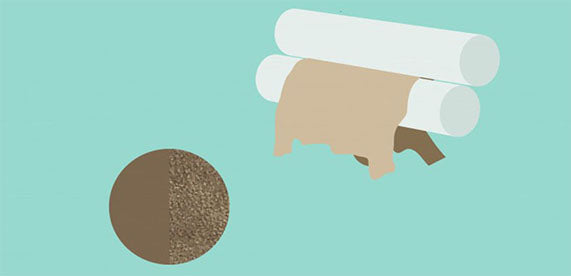 ©Noémie Daval - National Leather Council
©Noémie Daval - National Leather Council
**WHAT IS GRAINED LEATHER?
We must first differentiate between naturally grained leather which will have variations in grain depending on the location of the skin from that which has received pressure treatment and whose grain is very homogeneous at the grain level. The leather is artificially grained to beautify it and give it a personalized style.
The major leather goods brands have created their “own grain” in order to give a signature to their items. These grain patterns are trademarked and must not be counterfeited by leather manufacturers.
Artificially grained leather is strong in nature as these created grains strengthen the grain of the leather. With use, scratches and small scrapes will be less visible than on smooth leather. This leather is therefore generally used for the manufacture of bags, sofas, car seats or shoes.
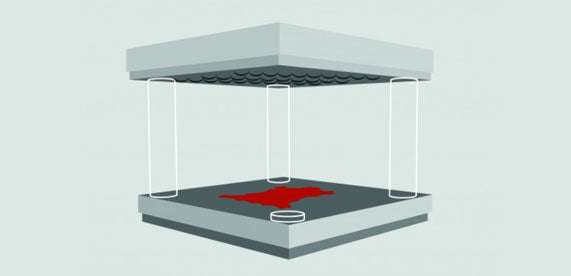 ©Noémie Daval - National Leather Council
©Noémie Daval - National Leather Council
SURFACE FINISHES
After the dyeing work, the leather receives a surface finish (more or less thick film) which aims to protect and beautify the material. This finish is chosen based on the quality of the skin.
WHAT IS ANILINE/DIPPED LEATHER?
This type of finish is reserved for full-grain leather without imperfections : it involves immersing the leather in a bath to tint it in the mass (by dipping). This type of leather retains a silky/waxy feel and will develop a patina over time. The leather retains its natural appearance. Aniline leather is leather without additional finishing, it is more sensitive to stains and friction. It can sometimes receive a thin transparent layer (low thickness) which does not alter the properties of the skin and allows it to be preserved (minimal protection). These components can be based on casein, plasticized shellac, or albumin for example.
WHAT IS SEMI-ANILINE LEATHER?
The semi-aniline leather has received a lightly pigmented protective layer (allows it to resist the sun and bad weather) . This leather is dyed by dipping it in a bath and is covered with a light pigmented layer (also called semi-pigmented leather) and a protective layer (aniline). Imperfections in the leather will be slightly hidden.
Nappa leather is a smooth, full-grain, semi-aniline leather: it has received a surface treatment and is pigmented. It is a supple and robust skin.
WHAT IS PIGMENTED LEATHER?
Pigmented leather is leather that has received several layers of opaque dyes which hide imperfections and therefore make it more resistant. This type of leather often has a glossy appearance. The finish hides flower defects while enhancing the color of the flower.
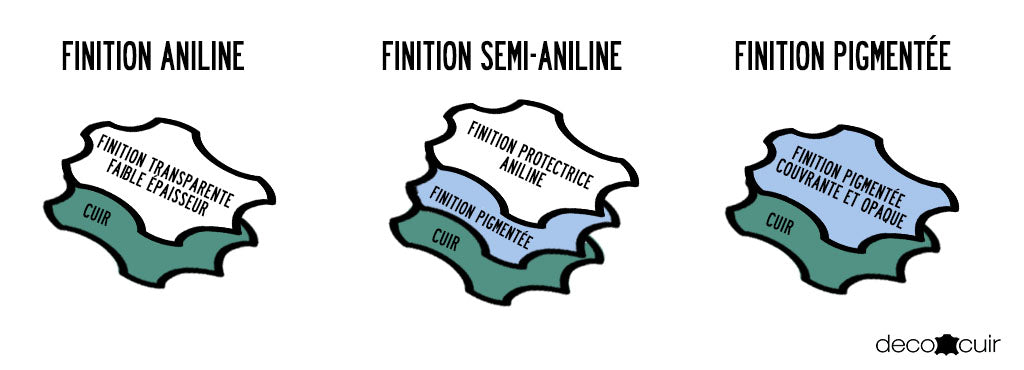
WHAT IS FIRST AND SECOND CHOICE LEATHER?
Leather is a natural material that includes imperfections such as scars, wrinkle marks, holes, etc. These defects can be positioned anywhere on the skin (each skin is unique). The leather skins sold as first choice may therefore contain some defects but they are usable at a minimum of 75% of their surface area . There is no major defect preventing the manufacture of a part using at least 50% of the surface of the skin.
Second choice leathers are skins/pieces where there may be: marked folds, small imperfections, wrinkles, scars, scratches, small holes or stains. These leathers have more defects than first choice leathers and these defects can be distributed over the entire skin. The skins can be used at a minimum of 50% of their surface area. These skins are intended for the manufacture of small parts which can be positioned around defects in order to make the best use of their surface.
VIEW 2ND CHOICE LEATHER >
DIFFERENT ANIMALS
The most commonly used leathers:
-
Cattle : calf, cow, calf, bull, bison, etc.
Most used, large size, flexible or firm for leather goods, furniture, shoe industry.
-
Sheep: lamb, ewes, mutton
Soft leather, very small and smooth grain, small skin, mainly for clothing, jewelry, luxury items, shoes. Sheep can be worked while retaining its wool.
-
Goats: goat, kid, billy goat, chamois, deer, caribou...
Slightly firm leather (unless it is tumbled), specific grain (naturally quite marked), small hide, mainly for sheathing, leather goods and shoes.
-
Pigs: pork, pig, peccary...
Entry-level leather. Specific grain: leather goods and glove industry lining.
Exotic leathers:
-
Reptilians: iguana, crocodile, alligator, caiman, lizard, chameleon...
Small skin and very regular scale. The cost is very high, which limits its use to luxury items.
-
Snakes and water snakes: python, boa...
Fragile skin requiring reinforcement or lining, leather goods and footwear use.
-
Fish: Nile perch, salmon, shark, dogfish…
Relatively small and thin skins. A sector that has been seeking to develop for several years. Shagreen is fish leather. The leather of shagreen skin is unique and very hard. It is made up of small mineral balls which give it a very particular grain. This leather is also characterized by its central pearl, often white in color, which is very coveted.
-
Various exotic animals: ostrich, kangaroo…
Ostrich skin is the most elaborate of this family, especially appreciated for its appearance with its pimples, which are the marks of the feathers. The ostrich leg is also appreciated for its scaled appearance. It is widely used for small leather goods or watch straps.
 |
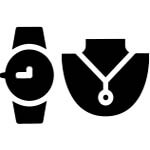 |
 |
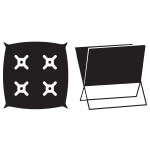 |
 |
| Furnishing | Jewelry | Shoe | Decoration | Gloves |
 |
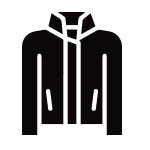 |
 |
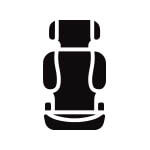 |
| Leather goods | Garment | Binding | Saddlery |

This guide is given for information purposes only; the specificities of each skin must of course be taken into consideration (notably flexibility and thickness). Leather is a noble material made up of small defects (scars, marks, differences in color, etc.) which only serve as a reminder that the material is also alive.
HOW DO WE MEASURE THE SURFACE OF OUR LEATHER SKINS?
The surface area of a skin can be measured in m2 or foot2 (footage). The oldest unit of measurement is the foot: which approximately corresponds to the size of a human foot (1 foot = 0.3048 m - 1 foot2 = 0.0929 m2). For simplicity, we have chosen to give you measurements in m2, the price of our leathers is therefore based on this measurement.
SKIN SIZE TABLE
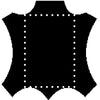 To help you choose the size of the skin (in m2), we provide you with a table with values in cm. Please note, this table is provided for information purposes only to give you an idea but does not take into account all the specificities of each skin (specific to each animal). The dimensions given correspond to the size of a rectangular piece that can be cut from the skin (the head, sides and legs are not included in the measurements). Dimensions are approximate. For a specific project, do not hesitate to contact us so that we can check the dimensions.
To help you choose the size of the skin (in m2), we provide you with a table with values in cm. Please note, this table is provided for information purposes only to give you an idea but does not take into account all the specificities of each skin (specific to each animal). The dimensions given correspond to the size of a rectangular piece that can be cut from the skin (the head, sides and legs are not included in the measurements). Dimensions are approximate. For a specific project, do not hesitate to contact us so that we can check the dimensions.
| From 0.10 to 0.20 m² | From 0.20 to 0.30 m² | From 0.30 to 0.40 m² | From 0.40 to 0.50 m² | From 0.50 to 0.60 m² | |
|
SIZE IN CM |
30 x 40 cm | 30 x 45 cm | 35 x 50cm | 40x50cm | 45 x 60 cm |
| From 0.60 to 0.70 m² | From 0.70 to 0.80 m² | From 0.80 to 0.90 m² | From 0.90 to 1 m² | From 1 to 1.10 m² | |
|
SIZE IN CM |
50x60cm | 45 x 70 cm | 60x75cm | 60x80cm | 65 x 85 cm |
| From 1.10 to 1.20 m² | From 1.20 to 1.30 m² | From 1.30 to 1.40 m² | From 1.40 to 1.50 m² | ||
|
SIZE IN CM |
65 x 90 cm | 75x100cm | 75 x 110cm | 75 x 120cm |
HOW DO WE MEASURE THE THICKNESS OF OUR LEATHER?
The thickness of leather is measured with a measuring stick . We offer leather thicknesses ranging from 0.5 to over 3 mm. The thicknesses of the pieces of leather can vary by plus or minus 0.3 mm.
THE CHOICE OF THE THICKNESS OF A LEATHER
Depending on the animal (and its age) the leather can have a maximum thickness of around 2 mm for goat and lamb leathers and 6 mm for cattle. Then, each tanner can refine the leather with machines to reduce its thickness and thus meet the demand of its customers. Generally, the minimum thickness is around 0.5 mm. You should know that the finer the leather, the more it will be affected by deformation. The choice of leather thickness for your creations depends on many factors (technical and aesthetic).
HOW TO MAINTAIN LEATHER?
Leather is a living material that weathers and embellishes. To respect this noble material and maintain its beauty, it is necessary to maintain it regularly. It is important to protect the leather from water, dirt, sunlight (to avoid color changes), and heat (risk of cracking). To do this, you must have a colorless waterproofer (solvent-free – water-based), a glycerin soap to clean the leather and a nourishing milk or grease to nourish and protect the material. Please note that not all leathers are maintained in the same way. For example, suede and nubuck are very fragile and their maintenance is limited to the use of a soft brush or a crepe brush (leather eraser) to scrub imperfections. It is also essential to waterproof them, just like vegetable tanned leather and dipped lambskin. Mineral tanned leather requires little maintenance given the substances used during its transformation. Widely used and known to everyone, shoe polish should only be applied to shoes because it blocks the pores of the leather and prevents it from breathing (risk of cracking) .
SAMPLE REQUEST
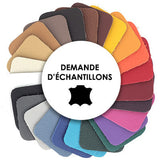
DO YOU HAVE A DOUBT ABOUT THE COLOR OF A LEATHER, LACE OR STRAP?
To get an idea of the color rendering, thickness and suppleness of the leather that we sell in whole skins , we offer the sending of samples. We also offer samples for our leather straps and laces.


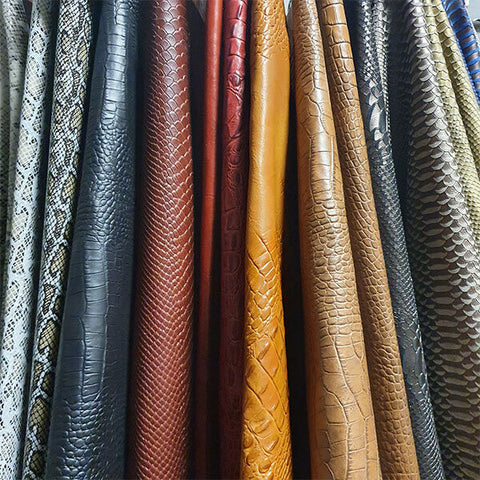

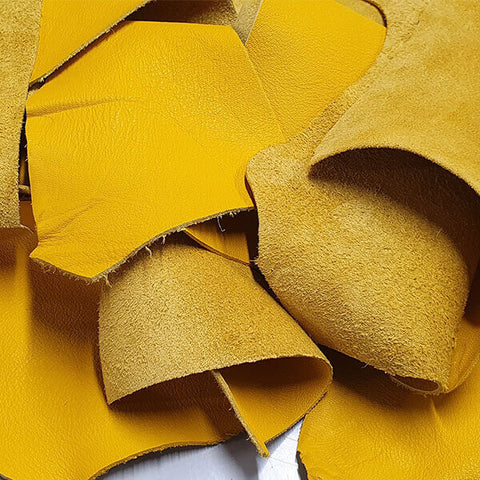
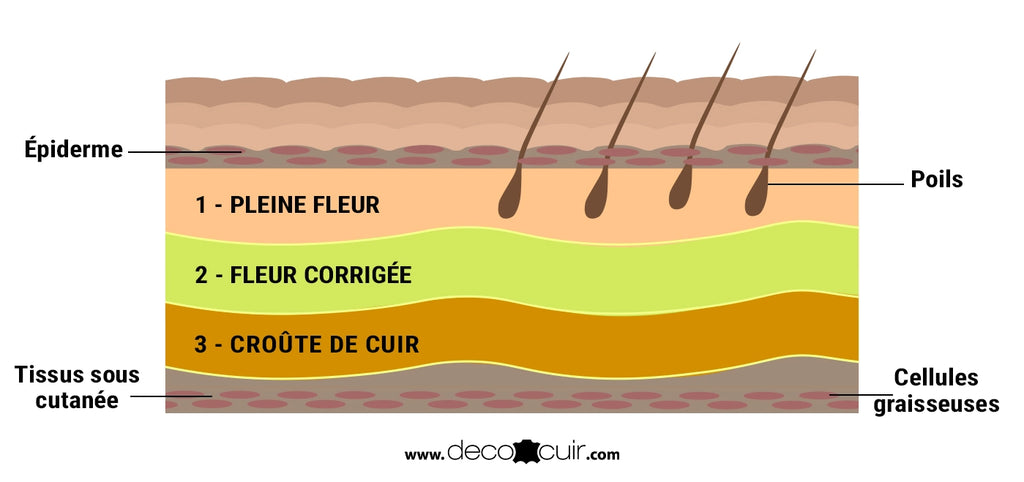
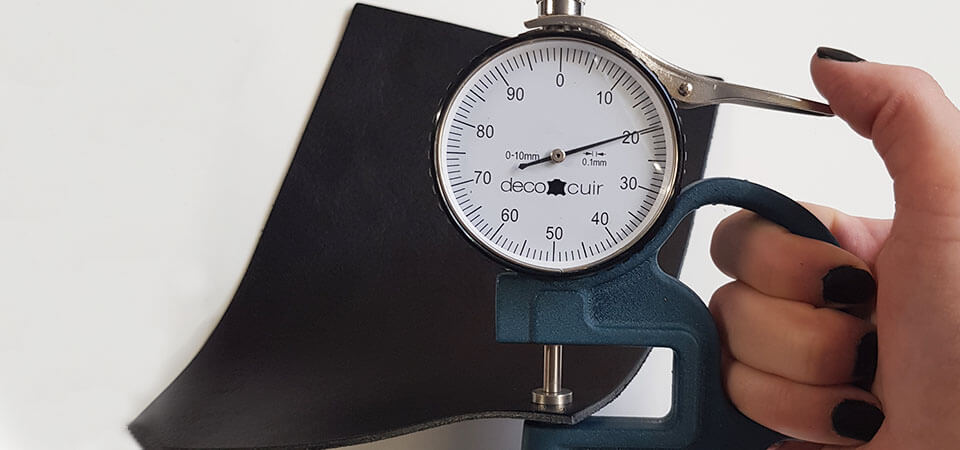








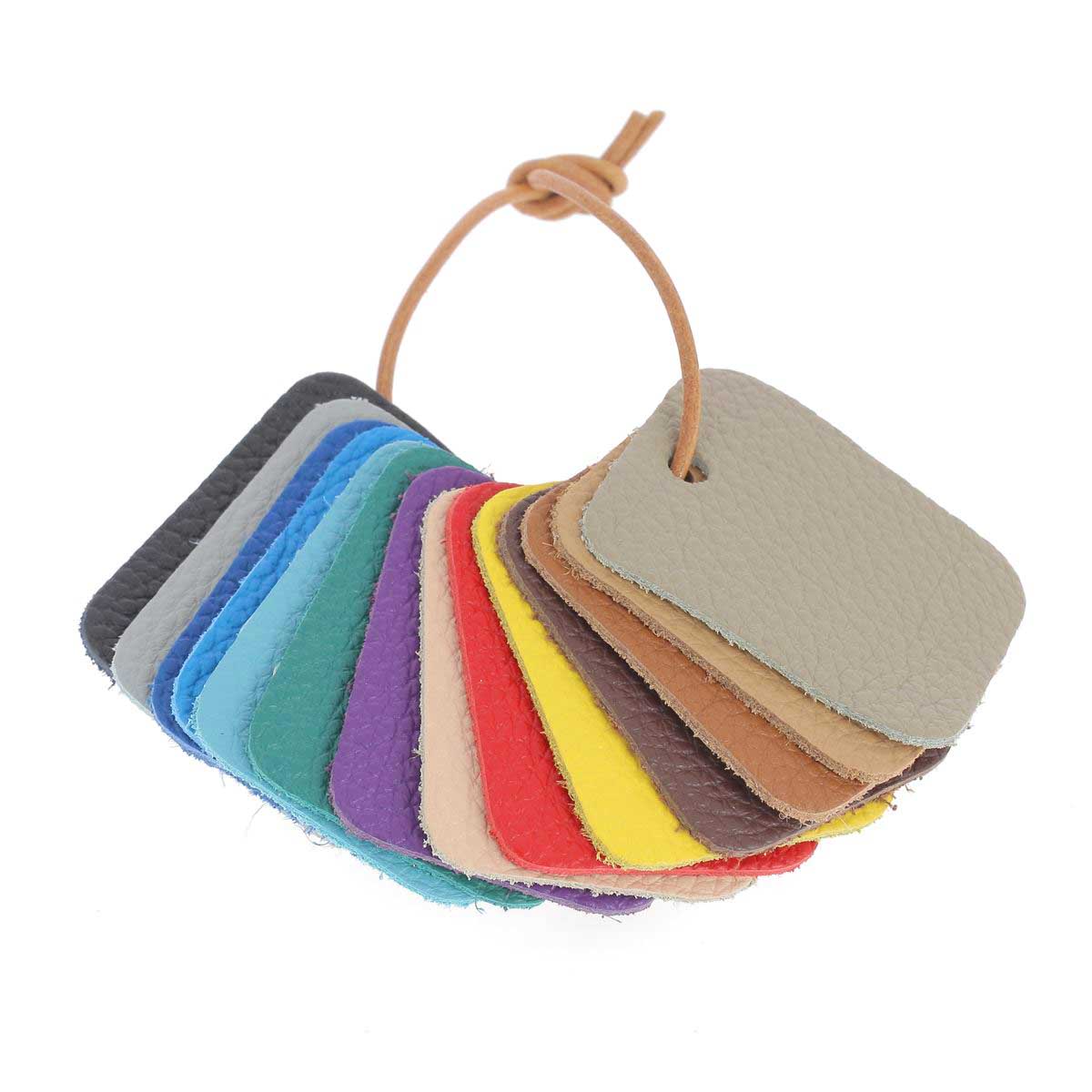
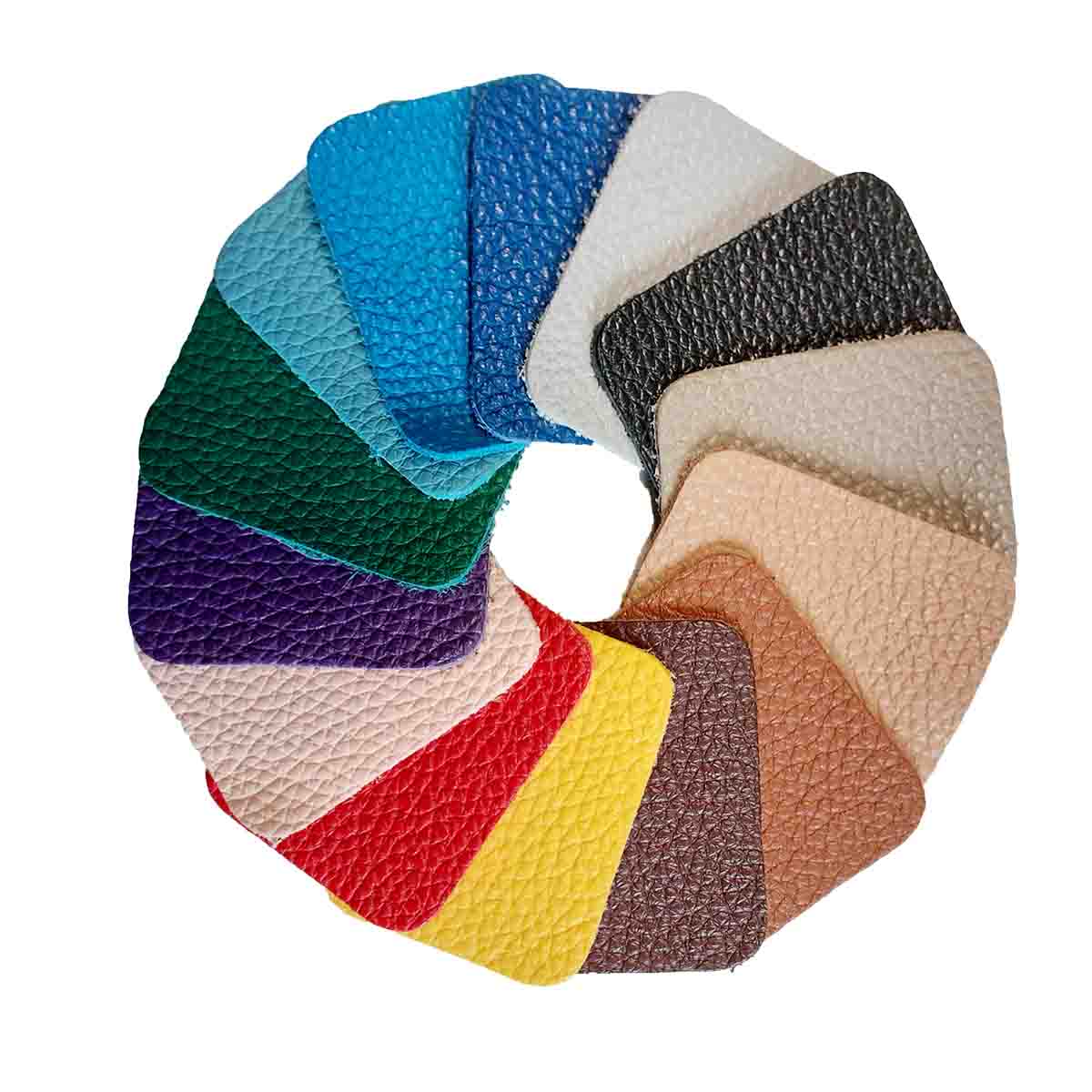


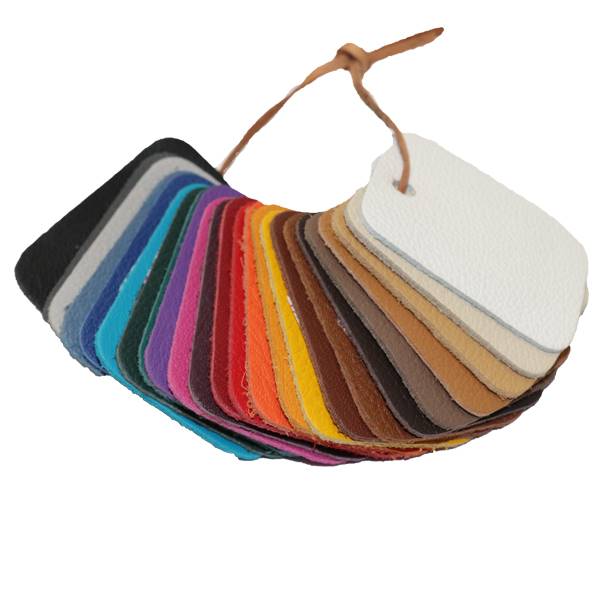
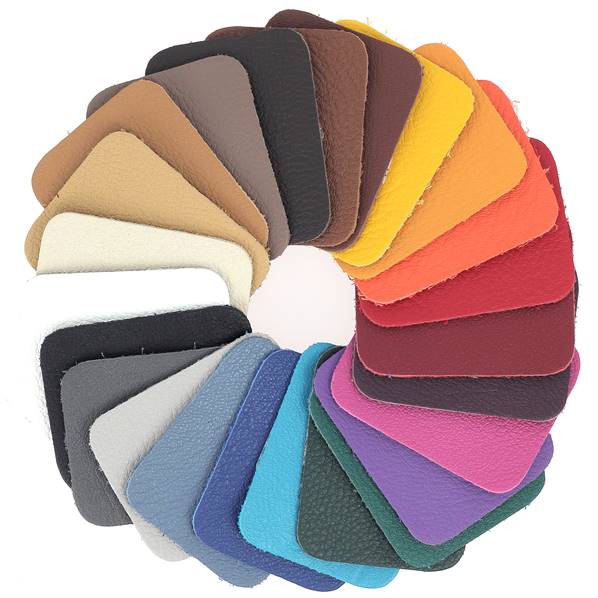




85 comments
DECO CUIR
Bonjour Hendrickk,
Vous trouverez notre lettre en cuir autocollante ici : https://www.decocuir.com/collections/lettres-autocollantes-en-cuir
et nos matoirs alphabet ici : https://www.decocuir.com/collections/jeux-de-matoirs-3d
Nous n’avons pas d’autres jeux de lettres prévus pour le moment.
Bonne journée,
L’équipe Deco Cuir
HENDRICKX
Bonjour,
L’Art Déco est très à la mode. Pensez-vous proposer dans les semaines à venir un jeu de lettres de l’alphabet dans ce style ?
D’avance merci.
Cordialement
SHe
Deco Cuir
Bonjour,
Pour la confection de chaussons en cuir, nous vous conseillons le cuir de la gamme SWEET 2 https://www.decocuir.com/collections/cuir-souple-sweet-morceaux-piece-fleur-vachette-qualite-italie ou GRANITE https://www.decocuir.com/collections/cuir-grain-granite
N’hésitez pas à consulter notre tutoriel complet : https://www.decocuir.com/blogs/blog-tutoriel-patron-cuir/tutoriel-chaussons-cuir-bebe-patron
Bonne fin de journée,
L’équipe Deco Cuir
Agnès
Bonjour
Quel cuir pour faire des chaussures et pour les semelles s’il vous plaît ?
Type chaussures tige haute à lacets
Anonymous
Bonjour Alyssia,
Il existe bien un produit pour durcir un cuir « le fixatif durcisseur » : https://www.decocuir.com/products/fixatif-durcisseur-finition-cuir-250ml
Mais si celui-ci ne doit pas toucher les pierres, je vous conseille plutôt un cuir plus ferme. Effectivement, la croûte de cuir est souvent très souple.
Dans les filtres, sélectionnez la souplesse « Cuir mi-souple mi-ferme ». Ces cuirs seront assez fermes et en même temps, assez souple pour pouvoir les travailler.
Bonne journée,
L’équipe Deco Cuir
Alyssia
Bonjour,
J’ai reçu y’a quelques jours ma commande, je viens a peine de me lancer (ou plutôt l’envie de me lancer) dans la fabrication de pendentifs et bracelets incrustés de pierres…
J’ai commandé, surtout de la croute et de la fleur de veau… en ayant collé un morceau de fleur sur un morceau de croute, je n’obtient quand même pas une rigidité suffisante par rapport a ce qu’on peut trouver dans le commerce artisanale (bracelet, pendentifs dans un style viking, plutôt rigide…) me suis-je trompé de peau…? Ou est-ce que j’ai raté une étape, l’enduire d’un produit quelconque pour le rigidifier sachant que j’ai déjà mis la pierre entre les 2 couches de cuirs et que je peux pas appliquer de produit sur la pierre (opale, n’aimes pas les liquides…)
Anonymous
Bonjour Denis,
Pour rénover un cuir de tambour il faut sélectionner du cuir de mouton et plus précisément du cuir de parchemin : https://www.decocuir.com/collections/peau-cuir-agneau-basane-parchemin-reliure-enluminure-percussion
Pour les dimensions indiquées nous vous conseillons de choisir 2 peaux d’au minimum 0,65 m2 : n’hésitez pas à contacter directement le service clients : boutique@decocuir.com pour qu’ils aillent mesurer les peaux avant achat.
La peau sera de retour en stock dans 2/3 semaines.
Bonne journée,
L’équipe Deco Cuir
Bonnefoy Denis
Bonjour
Je souhaite rénover un tambour de crieur de diamètre utile 36 cm soit 42 à 45 cm hors tout.
Il me faudrait 2 peaux capables.
Pouvez-vous me renseigner sur le sujet et que me conseillez-vous ?
Merci d’avance.
Cordialement
Anonymous
Bonjour Marie-Claude,
Pour la confection d’un tablier en cuir nous conseillons une peau de veau/vachette souple d’environ 1m2 et d’épaisseur d’environ 1,2/1,4 mm. Notre gamme de cuir non suivie « Téo » s’y prête bien.
Je vous invite à filtrer les peaux sur notre catégorie : « Peau veau et vachette » : https://www.decocuir.com/collections/peau-cuir-veau-souple?sort_by=price-ascending&filter.p.m.filtre.epaisseur=1.2+mm&filter.p.m.filtre.epaisseur=1.3+mm&filter.p.m.filtre.epaisseur=1.4+mm&filter.p.m.filtre.souplesse=Souple&filter.p.m.filtre.souplesse=Tr%C3%A8s+souple&filter.v.price.gte=&filter.v.price.lte=
Nous vendons aussi des kits complets pour confectionner son tablier en cuir (à 49,00 € avec patron) : https://www.decocuir.com/products/kit-diy-tablier-cuir-atelier-barbecue
Le patron est aussi en vente séparément : https://www.decocuir.com/products/patron-tablier-deco-cuir
Bonne journée,
L’équipe Deco Cuir
Marie claude
Bonjour
Je souhaite réaliser, avec une machine à coudre standard, deux tabliers de barbecue pour homme
Soit genre patchwork de cuir avec plusieurs morceaux différents
Soit un morceau de cuir complet
Quel cuir me conseillez vous ?
Merci pour vos conseils
Marie Claude
Anonymous
Bonjour Benjamin,
Pour une couture à la machine à coudre, nous vous conseillons de prendre un cuir de veau souple avec une épaisseur entre 1,2 et 1,4 mm. Exemple ici : https://www.decocuir.com/products/morceau-cuir-satinlys-cappuccino-30×40cm-12mm
Pour une couture à la main, nous vous conseillons de prendre un cuir tannage végétal. Ce cuir sera plus ferme et de meilleure qualité pour votre carnet de notes. Exemple ici : https://www.decocuir.com/collections/morceau-cuir-tannage-vegetal-finition-teintee
Bonne journée
Cordialement,
L’équipe Deco Cuir
Anonymous
Bonjour Didier,
Nous vous conseillons d’utiliser un cuir avec une épaisseur entre 1,2 et 1,4 mm. Pour une couture machine, le cuir doit être souple ou mi-souple.
Voici les deux cuirs qui pourraient correspondent à votre demande : https://www.decocuir.com/products/grand-morceau-de-cuir-de-veau-satinlys-noir ou https://www.decocuir.com/products/peau-de-cuir-de-veau-lisse-noir-satine-h48-215
Bonne journée,
Cordialement,
L’équipe Deco Cuir
Didier
Bonjour, à toute l’équipe. J’aimerais réaliser un petit sac avec rabat, comprenant une poche intérieure zippée et dont les dimensions sont : 130 mm x 200 mm et composé d’un soufflet de 70 mm. Sachant que je doublerai le cuir d’un carton d’environ 1 mm pour la tenue du sac, ce carton étant lui-même collé sur un tissu synthétique pour l’habillage intérieur du sac. Je me dirigerai de préférence vers un cuir noir pleine fleur lisse de veau/vachette. Quelle épaisseur de cuir me conseillez-vous ? Pour l’ensemble de cette réalisation, pourriez-vous me communiquer un lien me permettant de visualiser ce type de cuir sur votre site. Merci, pour votre réponse.
Benjamin Gadras
Bonjour, je souhaite commander un cuir pour faire un carnet de notes, que me conseillez vous?
De couleur marron taupe.
Merci
Anonymous
Bonjour Sandrine, Pour confectionner des sous-verres en cuir nous vous conseillons un cuir tannage végétal de 1,4 à 1,6 mm d’épaisseur si vous souhaitez doubler votre pièce (contrecoller 2 pièces pour avoir un côté fleur des 2 côtés). Si vous ne souhaitez pas la doubler, il faut une épaisseur minimale de 2,5 mm. Voici les morceaux : https://www.decocuir.com/collections/morceau-cuir-tannage-vegetal et voici les peaux : https://www.decocuir.com/collections/peaux-cuir-tannage-vegetal Pour la découpe des sous-verres nous vous conseillons l’outil suivant (le cutter circulaire) : https://www.decocuir.com/products/cutter-circulaire-nt-cutter-ic-1500p-japon Bonne année 2024, L’équipe Deco Cuir
Sandrine
Bonjour,
Je découvre votre site, c’est une véritable mine.
Je souhaiterais faire des dessous de verre en cuir mais je ne sais pas quel type de cuir prendre. Pourriez-vouse conseiller, s’il vous plaît ?
Merci. Sandrine
Anonymous
Bonjour Pierre,
Nous n’avons pas à ce jour de gamme suivie « pull-up ». Les seuls cuirs « pull-up » que nous avons sont des lanières de collet : https://www.decocuir.com/products/laniere-cuir-collet-gras-tannage-vegetal-marron-fonce-49mm-160cm
La gamme de cuirs tannage végétal qui va le plus se rapprocher sont les croupons tannage végétal CARMIN, COGNAC, BLEU MARINE, NOIR ET MARRON : https://www.decocuir.com/collections/morceau-cuir-tannage-vegetal
L’équipe Deco Cuir
Fitz
Bonjour,
Quel cuir de vos gammes correspondrait à un cuir type ‘pull-up’ ?
Merci,
Bonne journée
Anonymous
Bonjour Rita Ngalula,
Les cuirs souples sont à privilégier si vous souhaitez les mixer avec du textile.
Nous vous conseillons notre gamme de cuir de vachette Sweet 2 ou du cuir d’agneau.
Nous vous souhaitons pleins de réussite pour votre activité.
L’équipe Deco Cuir
Rita
Bonjour déco cuir
Je m’appelle Rita Ngalula,
Je vous écris depuis la République démocratique du Congo
Je désire lancer ma ligne d’accessoires de mode : sacs , pochettes…
Quel type de cuir puis-je acheter tout en sachant qu’il sera mixer à d’autres textiles tels que : le wax, le raphia
Anonymous
Bonjour Françoise,
Pour la confection d’un carquois nous vous conseillons un cuir tannage végétal d’environ 1,6 – 2,2 mm d’épaisseur (tout dépendra de votre montage).
Pour retrouver toutes nos peaux : https://www.decocuir.com/peaux-cuir-tannage-vegetal-c102x2664027
Et tous nos morceaux : https://www.decocuir.com/morceau-cuir-tannage-vegetal-c102x2677112
Je vous invite aussi à aller nos anciens articles de blog « carquois » 😊
Les liens vous ont été envoyés par mail.
Bonne journée,
Bien cordialement,
L’équipe Deco Cuir
Anonymous
Bonjour Déco cuir
Félicitations pour votre site qui est très intéressant.
Pouvez vous m’aider à choisir le cuir afin de fabriquer un carquois.
Merci de votre réponse
Françoise
Anonymous
Bonjour Christine,
Effectivement pour doubler des bijoux nous vous conseillons de privilégier le cuir tannage végétal pour éviter tout risque allergique (emploi de tanins végétaux).
Aujourd’hui, en épaisseur, 0,5 mm ou 1 mm nous avons uniquement du cuir tannage végétal naturel mais vous pouvez le teinter avec une teinture à base d’eau ou de l’huile de pied de bœuf / huile d’olive (pour lui donner un effet bronzé).
https://www.decocuir.com/morceau-cuir-tannage-vegetal-c102x2677112
De plus, le cuir va se patiner avec le temps.
L’équipe Deco Cuir
Anonymous
Bonjour
Votre topo sur les cuirs est intéressant mais je ne trouve pas réponse pour mon cas
Je souhaite fabriquer des bijoux. Le cuir serait utilisé pour le dos de bracelet ou de médaillon et doit être suffisant fin pour un passage d’aiguille à coudre fine ( main pas machine à coudre)
2 questions pour m’aider à choisir :
1/ vers quel type de cuir dois-je m’orienter ?
2/ quel tannage convient le mieux pour un contact peau ( pas de décoloration si transpiration ou de produits pouvant être allergène ?)
Je vous remercie pour vos réponses
Anonymous
Bonjour M. Le Bras,
Pour refaire une ceinture, le mieux est d’utiliser un cuir tannage végétal ferme. Nous proposons une gamme de lanières de collet, parfaite pour la réalisation de ceinture cependant nous n’en n’avons pas de couleur blanche. Vous trouverez les lanières de collet ici : https://www.decocuir.com/laniere-sangle-ceinture-cuir-collet-vegetal-c102x2679725
Bonne journée,
L’équipe Deco Cuir
Anonymous
bonjour, quel cuir blanc prendre pour refaire une ceinture ancienne d homme? Merci
Anonymous
Bonjour,
Pour réaliser des bracelets de montre nous vous conseillons de sélectionner un cuir de veau/vachette de 1,4 mm d’épaisseur puis de le doubler avec du cuir tannage végétal de 0,5 mm d’épaisseur : https://www.decocuir.com/cuir-collet-tannage-vegetal-naturel-classic-05-15×20cm-c2x38439358
Nous devrions mettre en ligne un nouveau guide avec vidéo : « Comment faire un bracelet de montre en cuir ? » le mois prochain.
Bonne journée,
Bien cordialement,
L’équipe Deco Cuir
Anonymous
bonjour je souhaite me mettre a la fabrication de bracelet de montre en cuir. quel cuir pouvez vous me conseiller ainsi que l’épaisseur min/max
merci d’avance pour votre réponse
Anonymous
Bonjour Willy,
Nous vous conseillons d’utiliser du cuir tannage végétal assez épais (minimum 1,4 mm) : https://www.decocuir.com/peaux-cuir-tannage-vegetal-c102x2664027
N’hésitez pas à consulter notre tutoriel sur les sacoches de moto ici : https://www.decocuir.com/Blog.asp?ItmID=67162
L’équipe Deco Cuir
Anonymous
Bonjour,
Quel cuir conseillez vous pour des sacoches latérales de moto (bien costaud) ? Merci !
Willy
Anonymous
Bonjour,
Le cuir de la gamme Satinlys convient très bien pour la confection de sacs (le cuir est mi-souple mi-ferme). De plus, son épaisseur de 1,2 mm vous permet de le coudre avec une machine à coudre familiale.
Ce cuir est proposé en peaux ou en morceaux :
Morceaux : https://www.decocuir.com/cuir-veau-morceaux-qualite-satinlys-c102x2625168
Peaux : https://www.decocuir.com/peau-veau-satinlys-c102x3811968
L’équipe Deco Cuir
Anonymous
Bonjour Je souhaiterai réaliser un petit sac à main en cuir doublé de coton. Que me conseillez vous comme cuir ? Sachant que je coud avec ma machine à coudre non professionnelle . Merci !
Anonymous
Bonjour Gislaine,
Le cuir le plus résistant pour votre projet est le cuir de sellerie automobile (il existe en noir lisse ou grainé) : https://www.decocuir.com/peau-cuir-sellerie-automobile-ameublement-c102x2387898 Ce cuir est traité anti-UV et anti-griffures.
La deuxième option est le cuir de mouton (basane) qui est notamment utilisé pour les fauteuils club. Attention à ne pas sélectionner un cuir avec une finition aniline (qui est très sensible aux griffures) : https://www.decocuir.com/peau-cuir-agneau-basane-france-c102x2227515
L’équipe Deco Cuir
Anonymous
Bonjour,
Je souhaite recouvrir l’assise de chaises scandinaves vintages en teck de cuir noir (modelé EVA par NIELS KOEFOED) ; mon souci est double : quel cuir ayant une souplesse suffisante pour le travailler mais néanmoins résistant pour une utilisation quotidienne et donc quelle épaisseur de cuir ?
Merci pour nous permettre de vous poser des questions et bravo à votre site très bien fait avec tout le matériel et équipement proposés.
Bon weekend a vous.
Anonymous
Bonjour Monique,
Pour ce type de création, les lanières les plus résistantes que nous allons avoir sur notre site sont les lanières de collet : https://www.decocuir.com/laniere-cuir-collet-tannage-vegetal-ceinture-c102x1632006
Je vous invite à sélectionner directement une épaisseur de lanières de 3,3 à 3,6 mm. Ces lanières sont très résistantes, elles sont notamment utilisées pour faire des ceintures.
L’équipe Deco Cuir
Anonymous
Bonjour , je veux transformer un tabouret bois pliant en le dotant de sangles de cuir pour l’assise.
Je crains de faire une erreur en commandant au hasard…
Que dois-je privilégier pour l’esthétique ainsi que la solidité s’il vous plaît ?
Merci à l’équipe decocuir pour ……tout!
Anonymous
Bonjour Lorinne,
Merci beaucoup pour votre commentaire sur notre blog, effectivement nous conseillons le cuir tannage végétal pour la confection de bijoux (plus naturel et plus ferme/résistant), en ce qui concerne l’épaisseur je dirais entre 1,6 et 1,9 mm.
Effectivement sur vous souhaitez doubler vos créations, le cuir de porc est idéal et plus « respirant ». Nous allons bientôt rentrer une nouvelle gamme suivie de cuir de porc – Gamme VELVET (au plus tard fin février).
Etant donné que le cuir de porc est un cuir tannage minéral pour éviter toute allergie vous pouvez doubler vos bracelets avec du cuir tannage végétal naturel de 1 mm d’épaisseyr.
Enfin pour travailler vos tranches la gomme arabique/tokonole sont parfaits ou sinon vous pouvez opter pour une peinture de tranche (voir rayon finitions de tranche).
N’hésitez pas à nous envoyer des photos de vos créations nous sommes intéressés par la broderie sur cuir et aimerions voir vos résultats 😊
Bonne journée et à très bientôt,
L’équipe Deco Cuir
Anonymous
Bonjour,
J’ai découvert votre site il y a quelques jours et quelle chance, c’est un trésor d’informations et de matériel.
Je souhaite broder des bracelets en cuir et j’aimerai avoir votre avis :
J’ai vu dans un commentaire précédent que vous suggériez un cuir tannage végétal de 1,9 mm pour réaliser un bracelet. Puis-je faire de même?
J’ai aussi vu que vous montriez comment doubler une lanière avec de la peau de cuir doublure. Je me dis que pour cacher mes fils de broderie sur la croûte du cuir tannage végétal ce serait bien et j’adore le côté bicolore que ça donnerait. Ou vaut-il mieux que je brode sur du cuir autocollant et que je le double?
Comme je suis novice, je cherche la solution la plus simple mais avec de belles finitions. Est ce que le cuir doit être protégé ou nourrit comme il sera en contact avec la peau? y a t il un risque d’allergie? J’ai pensé à la gomme arabique pour finir les tranches.
Cela fait beaucoup de questions,
d’avance merci beaucoup,
Un bel après-midi à vous,
Anonymous
Bonjour Olivier,
Merci beaucoup pour votre commentaire !
Les cuirs “Granite” et “Arizona” sont des cuirs plutôt souples, il est donc préférable de les doubler pour donner plus de tenue à vos articles de maroquinerie.
Bonne journée, l’équipe Deco Cuir.
Anonymous
Bonjour,
bravo pour votre site en ligne il est vraiment bien fait et contient tout ce qu’il faut pour se lancer…
Je souhaite réaliser de petits articles de maroquinerie notamment un porte chéquier et un portefeuille.
Les cuirs de type grain “GRANITE” ou “ARIZONA” sont ils adaptés svp ?
Faut-il / peut-on prévoir de faire une doublure avec le même type de cuir éventuellement plus fin en les assemblant croute contre croute ?
Merci et encore bravo à Decocuir !
Anonymous
Bonjour Alain,
Merci beaucoup pour votre commentaire sur notre blog. En ce qui concerne le choix du cuir, celui-ci dépendra du rendu souhaité et du type de création. Effectivement un cuir épais ne veut pas dire rigidité et il faut parfois le renforcer avec du TEXON ou un fixatif durcisseur.
Si vous voulez un cuir ferme et épais, il faut privilégier un cuir tannage végétal (type collet) : https://www.decocuir.com/morceau-cuir-tannage-vegetal-c102x2677112 Nous essayons, au mieux, sur notre site de renseigner la souplesse de chaque cuir (voir les filtres).
Bonne journée, l’équipe Deco Cuir
Anonymous
Bonjour,
Merci pour les blogs, tutos et réponses.
Pour différents projets, je me retrouve avec la question: “épaisseur du cuir versus rigidité”. Vaut-il mieux prendre un cuir moyen et lui ajouter "une plaque rigide " (dont j’ai oublié le nom de la matière imputrescible) ou prendre un cuir plus épais et plus rigide…. Quel casse tête…!
Merci pour votre réponse.
Anonymous
Bonjour M. BEJOT,
Merci pour votre commentaire. Les prix sont affichés sur les différentes pages de notre site web. Pour visualiser les prix des cuir en peaux, allez sur cette catégorie : https://www.decocuir.com/cuir-peaux-entiere-veau-vachette-agneau-chevre-c102x498134
Pour les débutants dans le travail du cuir, nous proposons plusieurs kits outils pour démarrer sur cette page : https://www.decocuir.com/kit-demarrrage-outil-cuir-commencer-travail-creation-c102x2228066
Bonne journée, L’équipe Deco Cuir
Anonymous
Votre site est très enrichissant mais novice que je suis et déjà d’un âge un peu avancé je suis en cours de voir un projet du travail du cuir mais vous mentionnez pas de tarif ce qui pourrait inciter certains achats merci
Anonymous
Bonjour Jean-François,
Pour un collier pour chien il faut privilégier un cuir tannage végétal d’au moins 3 mm d’épaisseur : https://www.decocuir.com/morceau-cuir-tannage-vegetal-c102x2677112
En ce qui concerne « l’estampillage », celui-ci pourra être fait avec des matoirs alphabets : https://www.decocuir.com/jeux-de-matoirs-3d-c102x3750772
Je vous invite à aller voir le guide suivant : https://www.decocuir.com/matoir-guide-cuir-frapper-droit-video-c1200x67002
Enfin, pour la bouclerie, privilégiez de l’INOX 😉
Bonne journée,
L’équipe Deco Cuir
Anonymous
Bonjour, j’aimerais confectionner un collier pour mon chien. Il dois être très résistant (un molosse de 140 lbs) et j’aimerais tentez mes premier pas en maroquinerie. Je veux pouvoir faire des gravures, des estampillages, teintures (facultative) et que le collier sois sans entretien. Quel cuire et de quel épaisseur pourrais convenir a mon projet ?
Anonymous
Bonjour Corinne,
Pour une selle de moto nous vous conseillons de sélectionner un cuir de sellerie automobile : https://www.decocuir.com/peau-cuir-sellerie-automobile-ameublement-c102x2387898
Vous pouvez demander jusqu’à 3 échantillons de cuir en commandant l’article suivant (0,90 € – frais de port compris) : https://www.decocuir.com/demande-d-echantillon-3-cuirs-max-c2x18058882
Bonne journée,
L’équipe Deco Cuir
Anonymous
Bonjour !!
je souhaite refaire ma selle de moto en cuir que me conseillez vous ? Comment puis je avoir un échantillon pour vérifier la couleur (plutôt fauve ou alezan).
Merci pour votre réponse.
Anonymous
Bonjour Laetitia,
Pour une sacoche de vélo, nous vous conseillons soit un cuir tannage minéral de notre gamme SATINLYS (peaux : https://www.decocuir.com/peau-veau-satinlys-c102x3811968 ou morceaux : https://www.decocuir.com/cuir-veau-morceaux-qualite-satinlys-c102x2625168). Soit un cuir tannage végétal (1,6 ou 1,9 mm d’épaisseur) : https://www.decocuir.com/morceau-cuir-tannage-vegetal-c102x2677112 (existe aussi en peaux).
Pour les poignées de vélo, effectivement le cuir automobile serait l’idéal (c’est ce type de cuir qui est utilisé pour gainer les volants). Sinon vous pouvez aussi choisir un cuir tannage végétal mais il faudra bien l’imperméabiliser, l’avantage de ce type de cuir est qu’il se patinera avec le temps !
L’équipe Deco Cuir
Anonymous
bonjour
pour faire une sacoche à vélo qui sera à cheval sur la barre, que me conseillez vous? et pour faire les poignées du vélos en cuir ce serait du cuir automobile ?
merci de votre aide!!